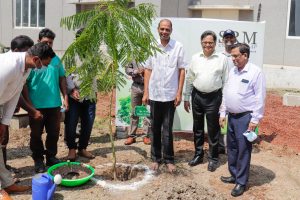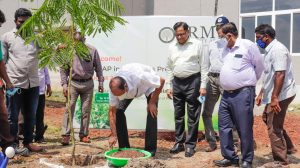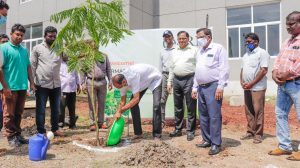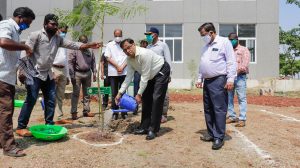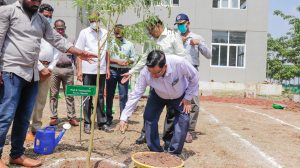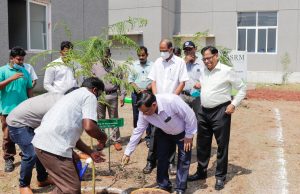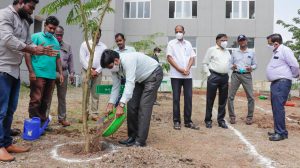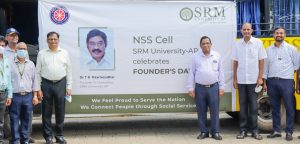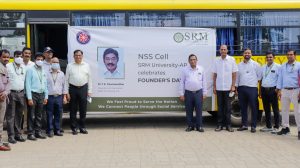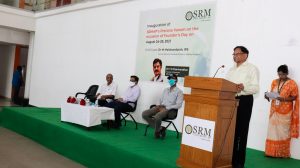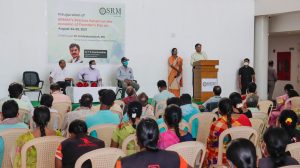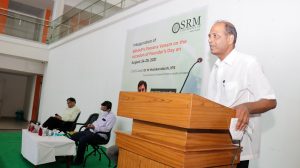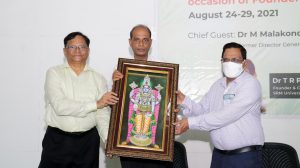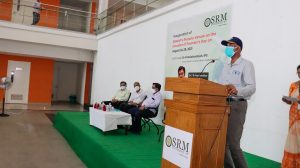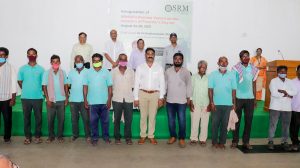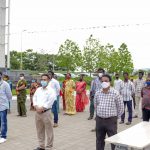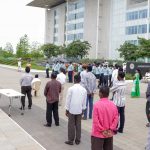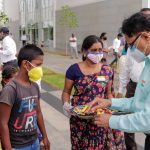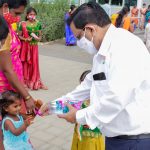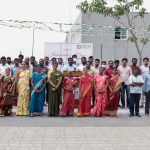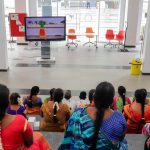SRM-AP All News
ALL News
- SRM University-AP initiates Prerana Vanam on Founder’s Day August 25, 2021
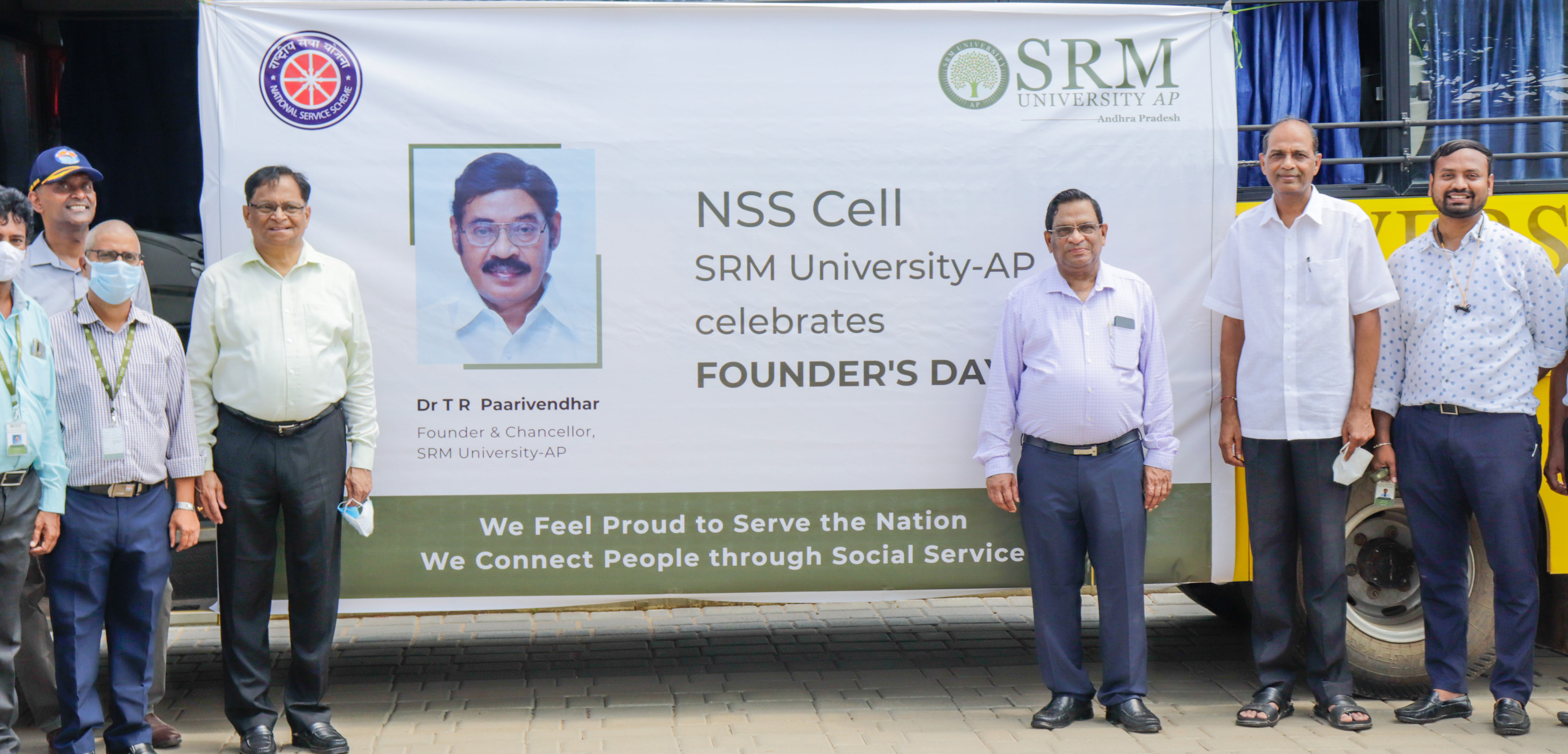 SRM University-AP celebrated the birthday of Founder Chancellor Dr T R Paarivendhar as Founder’s Day on August 24, 2021. Dr M Malakondaiah IPS, former Director-General of Police, Andhra Pradesh, was the chief guest of the day. The inauguration of Prerana Vanam, a week-long (Aug 24-29) event of planting trees across the university is being held as part of the celebrations. Prof V S Rao, Vice-Chancellor; Prof D Narayana Rao, Pro-Vice-Chancellor; Dr Vinayak Kalluri, Registrar; and Wg Cmdr Venkataachalam Sekkappan, Director-CLM addressed the gathering.
SRM University-AP celebrated the birthday of Founder Chancellor Dr T R Paarivendhar as Founder’s Day on August 24, 2021. Dr M Malakondaiah IPS, former Director-General of Police, Andhra Pradesh, was the chief guest of the day. The inauguration of Prerana Vanam, a week-long (Aug 24-29) event of planting trees across the university is being held as part of the celebrations. Prof V S Rao, Vice-Chancellor; Prof D Narayana Rao, Pro-Vice-Chancellor; Dr Vinayak Kalluri, Registrar; and Wg Cmdr Venkataachalam Sekkappan, Director-CLM addressed the gathering.In his address, Vice-Chancellor Prof V S Rao commended the services rendered by Dr T R Paarivendhar for the progress of the education sector. He advised the students to move forward by taking inspiration from the Chancellor. In his keynote address, Dr M Malakondaiah praised the management for establishing a university with world-class standards in a very short period of time and providing first-class engineering education. He also appreciated the Prerana Vanam endeavour that aims to promote greenery on the campus. “We all have a responsibility to protect and nourish the environment and I am glad that SRM AP is showing the appropriate way”, he added. Speaking on the occasion, Pro-Vice-Chancellor, Prof D Narayana Rao paid tributes to the leadership of Hon’ble Chancellor. He further explicated the benefits of growing trees and how that sustainably contributes to the oxygen level in the atmosphere.
Prerana Vanam is an initiative by SRM University-AP to fundamentally raise awareness among people about the importance of ecosystem preservation. This dream project of growing a diversified genus of trees across the university campus was named by Mr SP Sesha Sayee Kumar, General Manager, GPEMC. The formal event held in the university was attended by staff and faculty of the university and the distinguished guests inaugurated Prerana Vanam by planting tree saplings on the campus.
The celebration continued with the staff visiting the elderly at nearby Old Age Homes in Mangalagiri. Prof V S Rao lauded the gesture of the university that extends services to society. Dr Sivakumar, Deputy Dean Academic Affairs; Dr K Mohan, Director, ITKM and Corporate Communications; Dr Ch Lakshmi Rajyam, Medical Officer; and Ms Revathi Balakrishnan, Assistant Director- Student Affairs; Mr Venugopal, Media PRO were present on the occasion.
As part of the service activities to mark Founder’s Day, the NSS Department distributed masks and sanitisers for two days. Former DGP Dr Malakondayya formally started the distribution of the masks on August 24, Tuesday morning, and the university staff continued it to Wednesday as well. The university NSS coordinator Dr Lakshmana Rao and program officer Dr Parthasarathy informed that masks and sanitisers were handed over to cart traders, auto drivers, workers and to the elders at the Krishna Chaitanya Ashram in Mangalagiri town. Precautions to be taken to prevent corona infection were explained to the agricultural labourers in Kuragallu, Nirukonda and Nidamarru villages. Ms Revathi Balakrishnan, Mr Narendra Babu and several NSS volunteers participated in these activities.
Continue reading → - SRM University-AP observes Research Day to promote research among students August 21, 2021
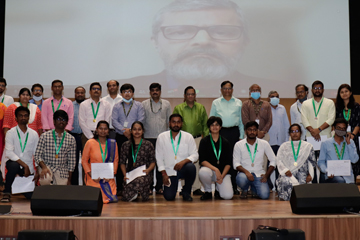 The third edition of Research Day was held at SRM University-AP on August 21, 2021, to provide an excellent opportunity for all the faculty members, research scholars and students to exchange and exhibit their ideas on research. Prof U B Desai, Chancellor, Anurag University-Hyderabad, was the Chief Guest of the event.
The third edition of Research Day was held at SRM University-AP on August 21, 2021, to provide an excellent opportunity for all the faculty members, research scholars and students to exchange and exhibit their ideas on research. Prof U B Desai, Chancellor, Anurag University-Hyderabad, was the Chief Guest of the event.In his speech, Prof UB Desai admitted that creating a research ecosystem in education has truly become important. During the last decade, the realisation happened, and it has been reflected in the National Education Policy, yet there is a long way to go. He further congratulated SRM University-AP for dedicating a day for research to motivate students towards the research pursuits. In his keynote address, “India’s Ascent to 5G”, he discussed some pertinent queries and showed the way forward. In every 10 years, there is an evolution in Communications. He made the audience aware of the 10 key technological trends- Artificial Intelligence, Autonomous Networks, Cyber Security, Distributed Ledgers, Dynamic Data, Extended Reality, Internet of Things, Quantum Computing, Autonomous Systems along with 3 software trends- Softwarization, Cloudification, Virtualisation which will shape the digital future. He further explained how Network evolution beyond the currently planned 5G is taking place. Research on 6G has already started, and in the future, it is poised to dominate 5G.
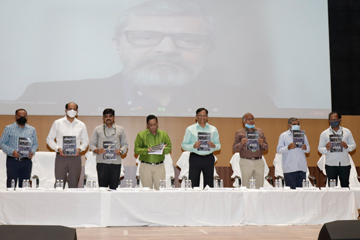 Prof Desai pointed out that India can make much improvement in Edge Computing and Metadata as these domains do not require huge resources. He further delved into the Evolved Network architecture and Indian Scenario and thrusts. He expressed that Research on 5G, Internet of Things and Cyber Security is critical to the National Interests. The nation thus is enhancing current Research and Developmental capabilities- domestic manufacturing and export-oriented. With interesting facts and charts, he laid down the mobile communication roadmap in India. In our country, mobile broadband is the premium source of the internet, with 80% of the internet traffic generated by it. An Indian consumes 11 Gb data per month per smartphone on an average which is the highest in the world. It need not be overemphasized that there is huge scope and opportunities in 5G research and beyond. Similarly, the Internet of Things is going to be another big wave. The next-generation devices and appliances will be hugely IoT based with less hassle in operation. Smart Cities-Sensors, Precision Agriculture, Digital Health, Industry 4.0, Automative are some of the sectors where it has substantial scope for application. Indian operators are also to launch nationwide NB-IoT services in the coming days.
Prof Desai pointed out that India can make much improvement in Edge Computing and Metadata as these domains do not require huge resources. He further delved into the Evolved Network architecture and Indian Scenario and thrusts. He expressed that Research on 5G, Internet of Things and Cyber Security is critical to the National Interests. The nation thus is enhancing current Research and Developmental capabilities- domestic manufacturing and export-oriented. With interesting facts and charts, he laid down the mobile communication roadmap in India. In our country, mobile broadband is the premium source of the internet, with 80% of the internet traffic generated by it. An Indian consumes 11 Gb data per month per smartphone on an average which is the highest in the world. It need not be overemphasized that there is huge scope and opportunities in 5G research and beyond. Similarly, the Internet of Things is going to be another big wave. The next-generation devices and appliances will be hugely IoT based with less hassle in operation. Smart Cities-Sensors, Precision Agriculture, Digital Health, Industry 4.0, Automative are some of the sectors where it has substantial scope for application. Indian operators are also to launch nationwide NB-IoT services in the coming days.In his welcome speech, Prof D. Narayana Rao, Pro-Vice-Chancellor, SRM University-AP, said that the universities and educational institutes need to trigger the thought process and inquisitiveness among the students beyond the classroom. Universities should give top priorities for research that creates a positive impact or change in society. The country’s universities and educational institutions need to be encouraged to perform transactional research that leads to the development of products needed for societal development. Universities and educational institutes should also look for collaborative research with the industry. Universities are the creators of knowledge and innovative ideas, providers of skilled manpower, agents of societal changes and symbols of international attention and prestige. Therefore rather than counting the number of publications, more focus is to be given to translational research.
Universities and educational institutes need to synergise so that both of them can be benefitted from the collaborative research outcomes. Falling behind innovation would mean falling behind in becoming a world leader. Therefore, for a country like India, aspiring to attain global economic leadership needs to be strongly encouraged and supported in research. Sri Narendra Modi, our Hon’ble Prime Minister, firmly believes that our future will be secure and global leadership will sustain only when we produce the next generation of world-class scientists, technologists, researchers and innovators. As India emerges as a global power, we need to move forward from being a knowledge consumer to a knowledge producer. It is the responsibility of universities and educational institutes to create knowledge.
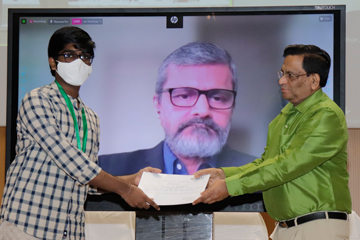 SRM University-AP provides abundant opportunities to faculty and students to carry out frontline research. National Education Policy-2020’s sharp focus is on research and multidisciplinary approach. National Research Foundation has been set up as per the recommendation of National Education Policy-2020 to significantly enhance the research contributions. Research is the way forward to be a world superpower. We must inculcate the desire to perform quality research in students even from the undergraduate days.
SRM University-AP provides abundant opportunities to faculty and students to carry out frontline research. National Education Policy-2020’s sharp focus is on research and multidisciplinary approach. National Research Foundation has been set up as per the recommendation of National Education Policy-2020 to significantly enhance the research contributions. Research is the way forward to be a world superpower. We must inculcate the desire to perform quality research in students even from the undergraduate days.In his speech, Prof V S Rao asserted how the nascent university has created its reputation in the education world of India. In fact, SRM University-AP has achieved several marvels in the last 30 months, including many research publications, projects, and several patents. Since its inception in 2017, the university has published over 500+ papers, 22 patents and 36 funded projects with an outlay of about Rs. 20 crores. He further emphasised that, unlike several other universities, SRM University-AP has research embedded in the curriculum. SRM University-AP does not believe in keeping research outside the curriculum. The capstone projects, research based learning, undergraduate research project, research internships with international universities or industry-SRM University-AP offer a plethora of opportunities to the students to bring out the inner researcher among them.
SRM University-AP firmly believes that a research eco-system should be inculcated among the students. The students must learn how to think and question and how to find the answers. Agreeing with Prof D. Narayana Rao, Prof VS Rao also mentioned that the National Education Policy-2020 puts a great emphasis on research since the importance of research need not be debated today. SRM University-AP thus introduced Research Day to impart curiosity towards transcendental knowledge among the students.
“Book of Abstracts” was launched by Prof V S Rao in the gracious presence of Prof UB Desai, Prof T Ragunathan, Associate Dean-Engineering, Prof Bandi Kamaiah, Dr B Siva Kumar, Deputy Dean and other dignitaries. 217 research abstracts were selected for presentation after review and scrutiny. 22 students out of them have received Gold medals for the research, and 9 students secured silver medals. All medal winners were felicitated in the event.
Continue reading → - Final year students get placed in ZS Associates August 21, 2021
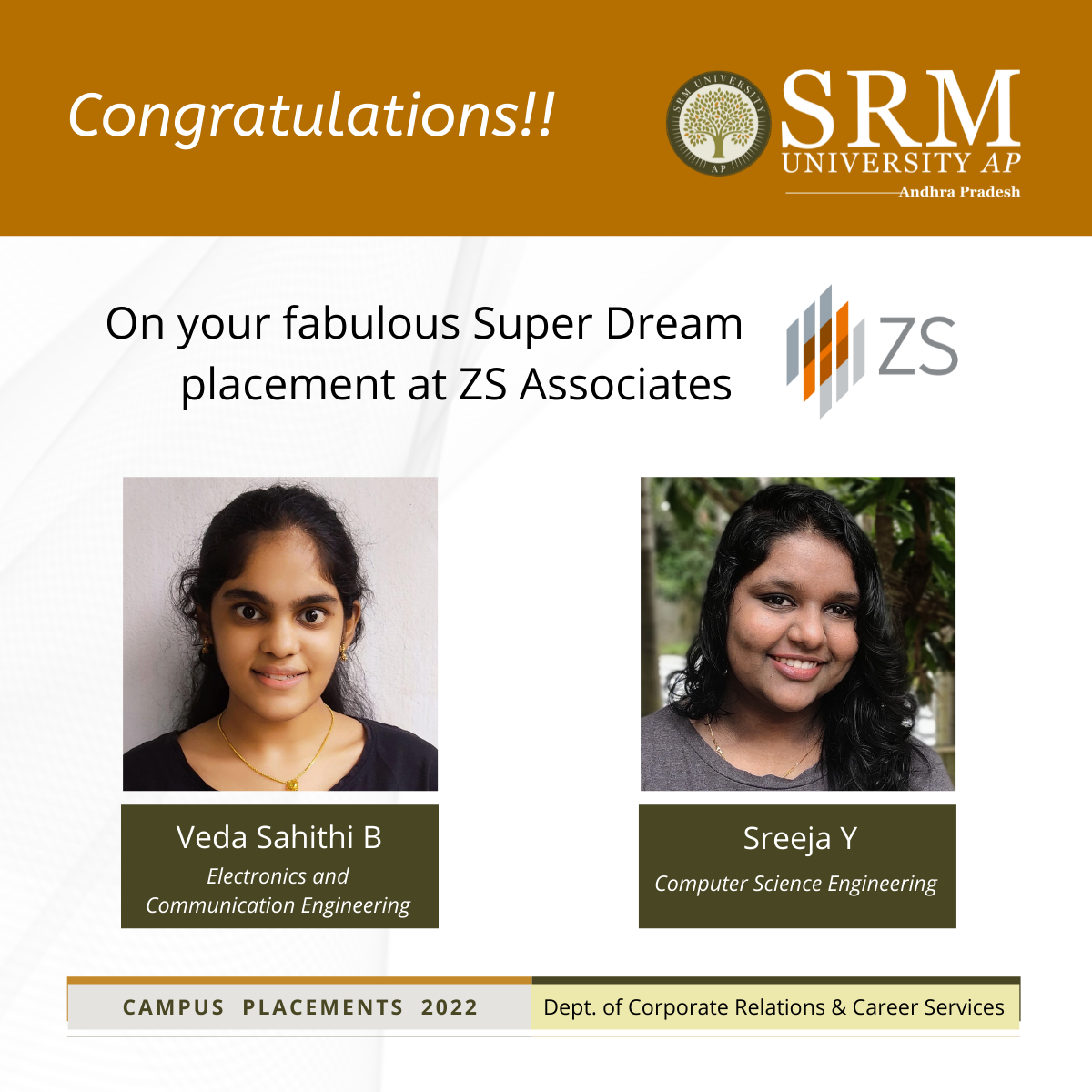 Bandi Veda Sahithi from the Department of Electronics and Communication Engineering, and Sreeja Y from the Department of Computer Science Engineering have been placed at ZS Associates with an exciting CTC of 14.35 LPA.
Bandi Veda Sahithi from the Department of Electronics and Communication Engineering, and Sreeja Y from the Department of Computer Science Engineering have been placed at ZS Associates with an exciting CTC of 14.35 LPA.Students started their preparation two months prior to the month of placements (approximately April-May and placements started in July). Following a disciplined timetable, and the CCC training given by the university, students have achieved their dream job offers! As Sreeja Y is a Computer Science Engineering Student, she mainly focused on DSA, DBMS, OOPs, OS and Aptitude (sources she used to prepare are Geekofgeeks, YouTube, Hackerrank, Leetcode for coding, W3schools).
The Curriculum for placement provides intensive training for 1 and a half month where the students receive CCC training, Domain training (TIME), and Aptitude training. The CCC Classes helped students understand DSA concepts and apply those concepts in coding. In the Domain training students were taught DSA, CN, OOPs, OS and it helped them further in SQL, DBMS concepts.
Sreeja expresses her gratitude for the guidance, training and sources of knowledge she received from SRM University-AP. “Approximately 75 companies lined up for recruitment in a month. Placement Cell really gives us great and wide opportunities to achieve our goals.” “The placement cell is a wonderful interactive platform that connects various companies with the university, providing abundant opportunities”, added Veda Sahithi.
Continue reading → - Dr Balaga Mohana Rao receives Best PhD Thesis award from IIT Bombay August 19, 2021
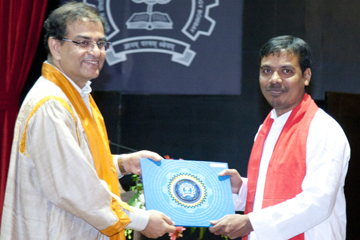 Dr Balaga Mohana Rao, Assistant Professor from the Department of Economics has been awarded the best PhD thesis award in the 59th IIT Bombay convocation held on August 07, 2021. The thesis titled The Early Warnings of the Impending Currency Crises and the Ensuing Macroeconomic Costs aims to develop an Early Warning System to identify the Currency Crises that would help in preventing an impending crisis and also in mitigating the devastating aftermath effects if that occurred.
Dr Balaga Mohana Rao, Assistant Professor from the Department of Economics has been awarded the best PhD thesis award in the 59th IIT Bombay convocation held on August 07, 2021. The thesis titled The Early Warnings of the Impending Currency Crises and the Ensuing Macroeconomic Costs aims to develop an Early Warning System to identify the Currency Crises that would help in preventing an impending crisis and also in mitigating the devastating aftermath effects if that occurred.The financial crises have enthused a huge theoretical and empirical debate in current times due to their recurrent nature in the history of economics. To highlight the importance of an economic crisis among various sections, Kaminsky et al. (1998) quote Kindleberger (1978) saying that academics are interested in a crisis as they have had a history of fascination for the crises, policymakers are interested because they want to prevent the crisis, and financial market participants are interested as they can make money out of it. The financial crises can be divided into two broad categories—currency and sudden stop crises, and debt and banking crises. The currency crises have not only swept away Argentina (2001), Brazil (1998–1999), Latin America (the 1980s), Russia (1998), Southeast Asia (1997) and UK (1992) (to name a few) but they also have caused serious economic adversities to India and BRICS in the recent past. A currency crisis encompasses one of the following four features or a combination of them owing to a speculative attack—both successful and unsuccessful attacks—on a currency: A sharp depreciation of a currency (possibly followed by devaluation) and/or huge depletion of foreign exchange reserves or an increase in interest rates by the central bank or imposing restrictions on capital flows. In this context, Dr Balaga Mohana Rao’s thesis focuses on developing an early warning system to identify the impending crises, finding the common determinants of currency crises and the aftermath effects on macroeconomic indicators.
“One may wonder why the crisis should be prevented or mitigated. The reason is that a full-blown crisis will not be just confined to the foreign exchange market or some other segment, but it will affect the whole economy” Dr Balaga said. He plans to extend his PhD work on Currency Crises and see it in the context of the International Price System.
Continue reading → - K Jeevan Sai from CSE lands in NielsenIQ with 11.79 LPA August 17, 2021
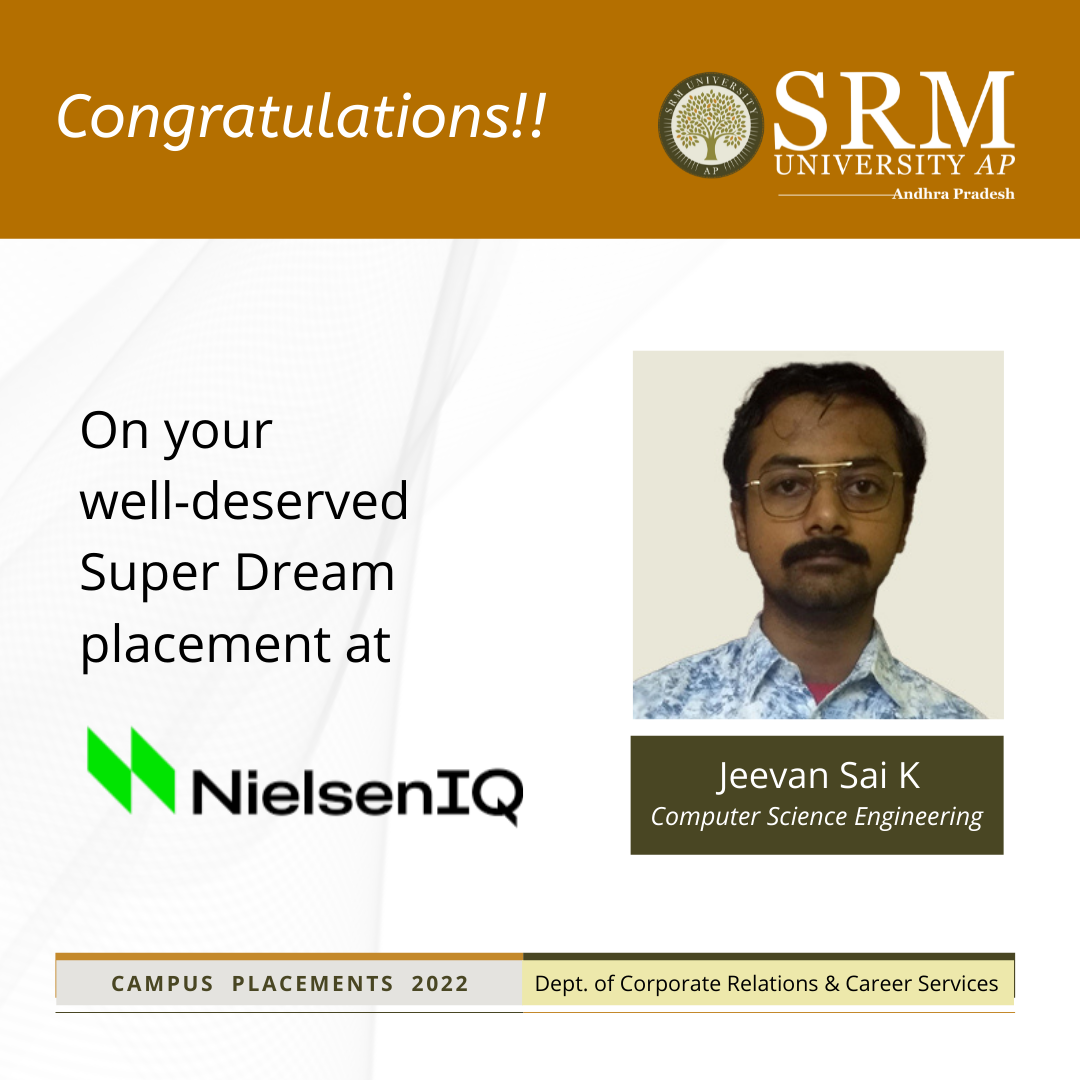 Kanaparthi Jeevan Sai, a B Tech final year student from the Department of Computer Science & Engineering, has secured an exciting job offer with an annual salary package of 11.79 lakhs from NielsenIQ, an industry leader in data points, detailed intelligence, and solutions. He will join the organisation as a full-time Java Software Engineer and work from the Chennai location.
Kanaparthi Jeevan Sai, a B Tech final year student from the Department of Computer Science & Engineering, has secured an exciting job offer with an annual salary package of 11.79 lakhs from NielsenIQ, an industry leader in data points, detailed intelligence, and solutions. He will join the organisation as a full-time Java Software Engineer and work from the Chennai location.NielsenIQ Consumer LLC is a dream destination for students who specialize in core areas of engineering. For the first three years, the university provided the students with the basics of programming, technical languages, data structures and algorithms. And later in the final year, the placement cell designed student-specific intensive training for all students aspiring for high-paying jobs. The training also covered all the possible model questions for coding rounds and discussed the pattern of previous years.
Jeevan Sai says that the projects need to be presented according to the company and it is important that the resume is well-written and simple. “Group discussions and some of the sessions which helped us to improve our personal and interview abilities and public speaking were arranged by the Department of CR&CS in association with Barclays (also a company). These and were led by industry experts. I thank the placement department for being very active throughout the placement season and clearing our doubts effectively, “Jeevan Sai stated.
Continue reading → - Heterojunction photocatalyst for the degradation and mineralization of pharmaceutical effluent: Clozapine August 17, 2021
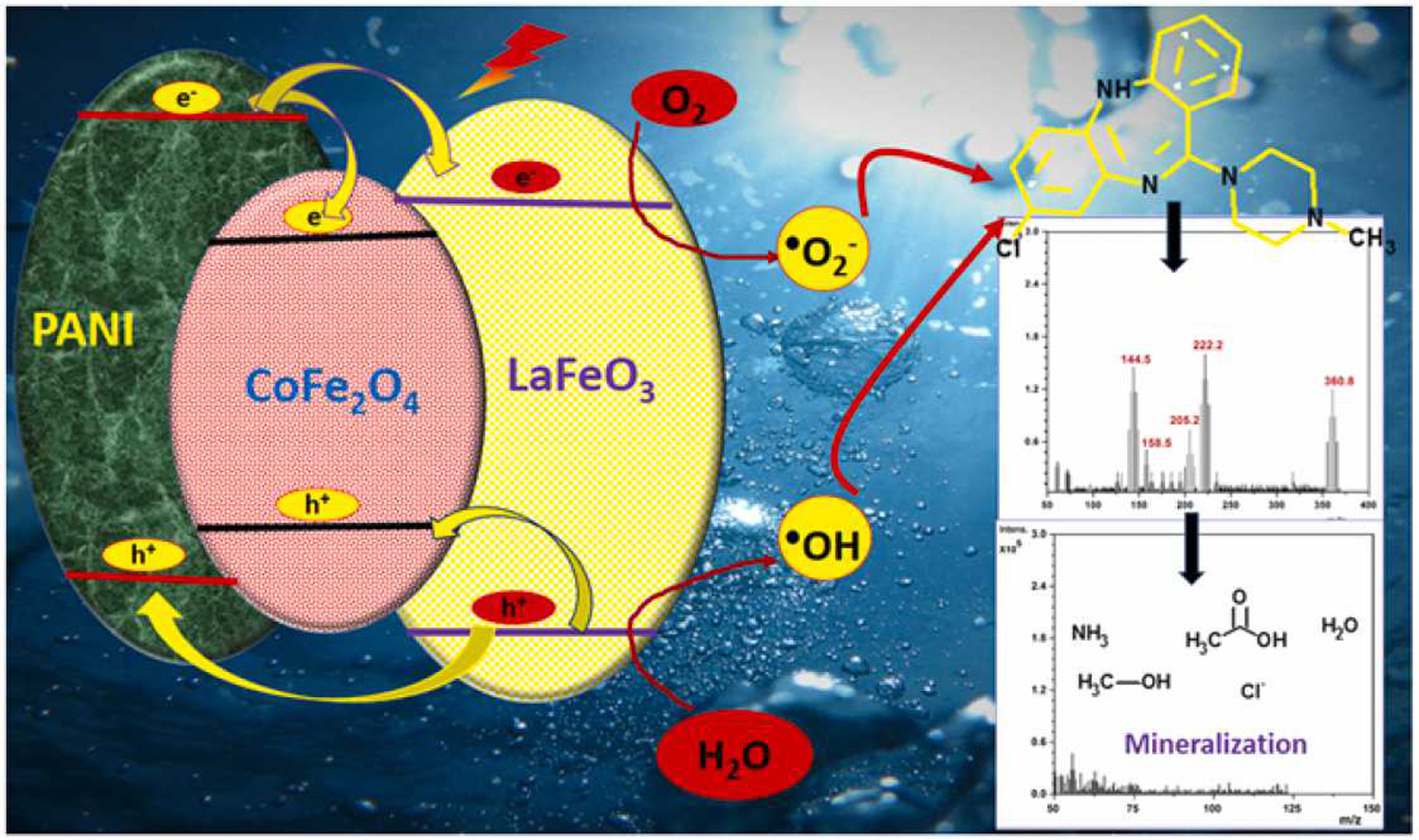 A research paper titled “Robust visible light active PANI/LaFeO3/CoFe2O4 ternary heterojunction for the photo-degradation and mineralization of pharmaceutical effluent: Clozapine” has been published by Dr Lakhveer Singh from the Department of Environmental Science at SRM University – AP, as a co-author, in Journal of Environmental Chemical Engineering, having an Impact Factor of 5.90.
A research paper titled “Robust visible light active PANI/LaFeO3/CoFe2O4 ternary heterojunction for the photo-degradation and mineralization of pharmaceutical effluent: Clozapine” has been published by Dr Lakhveer Singh from the Department of Environmental Science at SRM University – AP, as a co-author, in Journal of Environmental Chemical Engineering, having an Impact Factor of 5.90.Clozapine (CZP) is a second-generation antipsychotic medicine prescribed for the treatment of resistant schizophrenia. The reported side effects of CZP includes cardiometabolic, orthostatic hypotension, tachycardia, seizures, myocarditis, weight gain and obesity. In this research, a novel magnetic ternary PANI/LaFeO3/CoFe2O4 (PLC) heterojunction photocatalyst was developed for the degradation and mineralization of pharmaceutical effluent: Clozapine. The photocatalysts were found to be re-usable for 5 consecutive cycles.
This work has been in collaboration with Central University Jammu. The present study has a new insight into the development and fabrication of efficient ternary heterojunction towards promising application prospects in wastewater remediation.
Dr Lakhveer Singh is an Editorial Board member of the Journal of Biomass Conversion and Biorefinery – Springer (I.F. 2.60) and a Guest Editor for Bioresource Technology Reports- Elsevier.
Read the full paper here: https://doi.org/10.1016/j.jece.2021.106159
Continue reading → - PhD scholars engage in conversation with Pro-Vice-Chancellor August 16, 2021
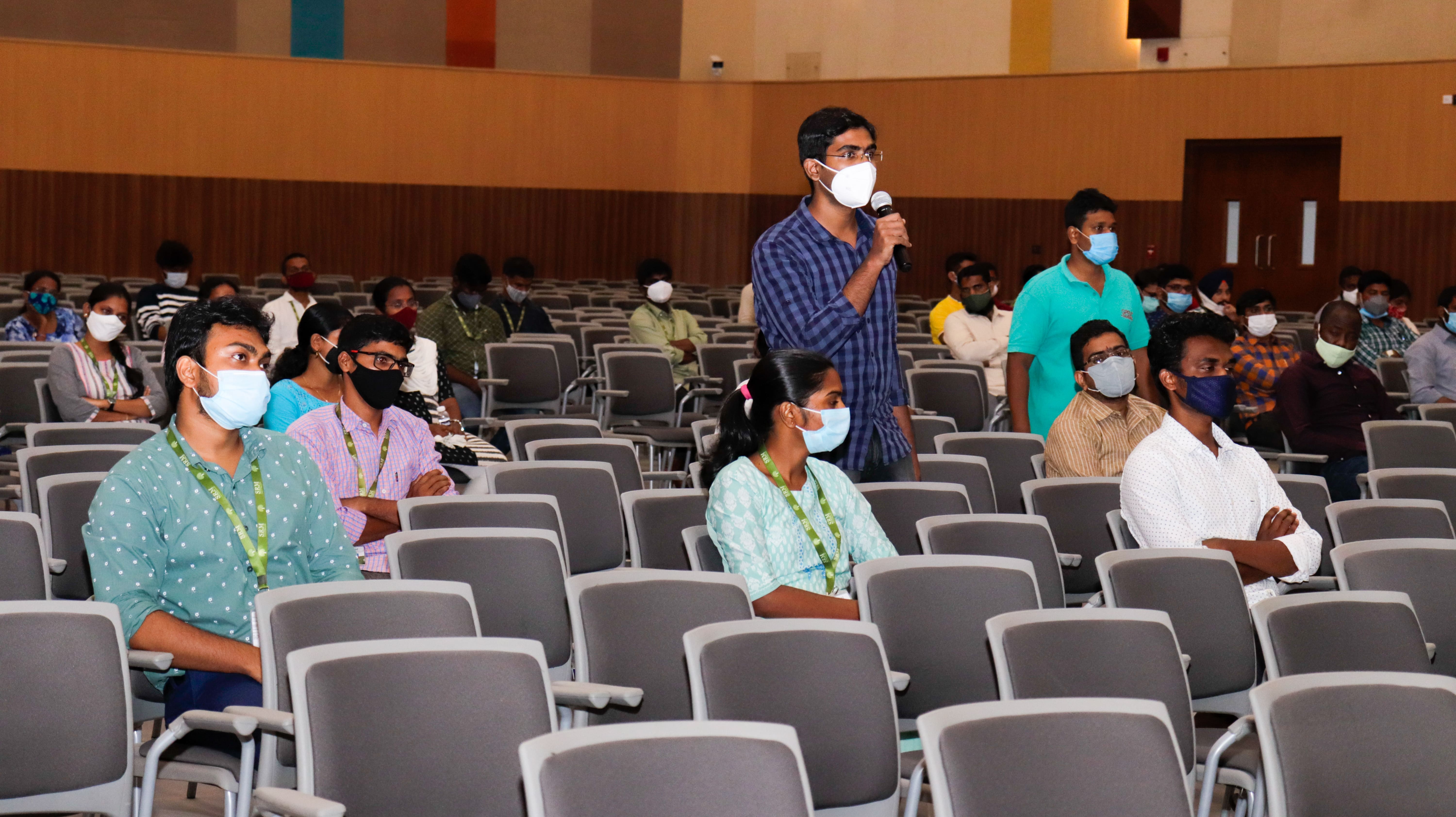 A conversation session between Prof D Narayana Rao, Pro-Vice-Chancellor and the research scholars of SRM University-AP was held on August 10, 2021. On this occasion, Prof Ranjit Thapa’s research scholar from the Department of Physics and Dr Nimai Mishra’s research group from the Department of Chemistry were felicitated for their sustained progress in carrying out research.
A conversation session between Prof D Narayana Rao, Pro-Vice-Chancellor and the research scholars of SRM University-AP was held on August 10, 2021. On this occasion, Prof Ranjit Thapa’s research scholar from the Department of Physics and Dr Nimai Mishra’s research group from the Department of Chemistry were felicitated for their sustained progress in carrying out research.Prof D Narayana Rao elaborated on the state of the art research facilities that SRM University-AP provide to carry out research 24×7. The university has completely centralized laboratories and the scholars can use any lab and equipment depending on the nature of their research. Well furnished lab spaces and working models with fire/safety and security provisions, modernized synthesis equipment and High-end characterization equipment, and fabrication facilities are available for custom made research.
X-ray diffractometer lab; Advanced Materials Laboratory with Radiant Ferroelectric analyser (DST project), custom made furnace for impedance measurements; Applied Nano Materials Lab with Electrochemical reactor, Photochemical reactor, Potentiostat-single channel; Genetics of Aging Laboratory; Colloidal Chemistry Laboratory; Organic Synthesis Lab; are few among the numerous laboratories that SRM University-AP extend to vigorous research projects that are being carried out on our campus.
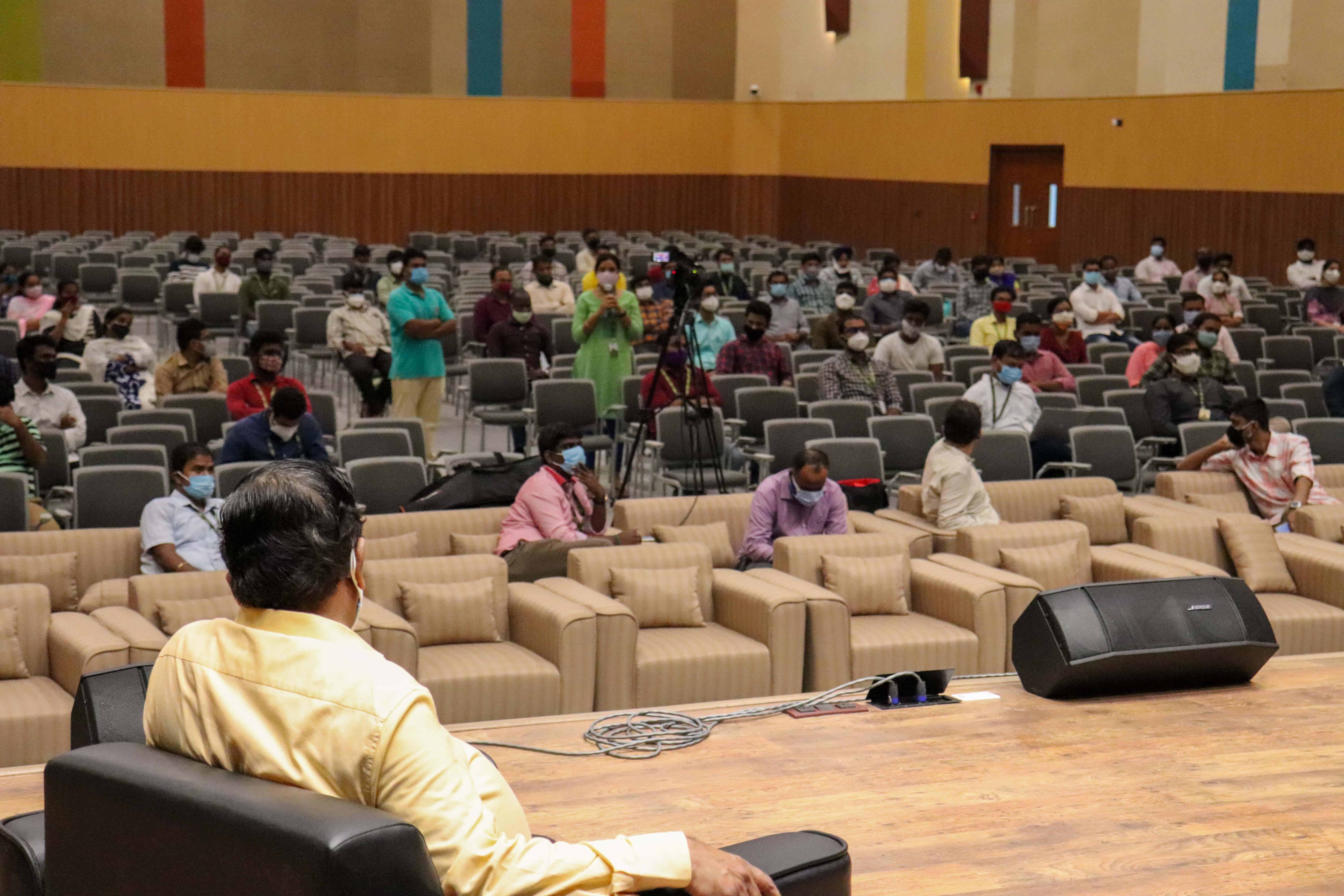
Faculty members and PhD students have published papers in top-ranking journals like Nature, Nature Microbiology, Advanced Energy Materials, Journal of American Society (JACS), Advanced Functional Materials, Advanced Sciences, ACS Nano, IEEE Journals etc The university conducts joint research programmes with NARL, ISRO/DoS and has two industrial projects.
Dr Nimai Mishra expressed that the university has been supportive in moulding young and vibrant researchers. “The scholars of SRM University-AP match up to the level of students from IITs, presenting papers in international conferences and publishing articles in Scopus indexed journals”, he added. Lately, Vasavi Dutt Vankadaru, one of the brilliant minds working on perovskite nanocrystals for light-emitting application, along with Akhil Syed, delivered flash presentation ( e-Poster) at an international conference organised by the Indian Society for Radiation and Photochemical Sciences (ISRAPS).
Continue reading → - Advances of surface-enhanced Raman and IR spectroscopies August 16, 2021
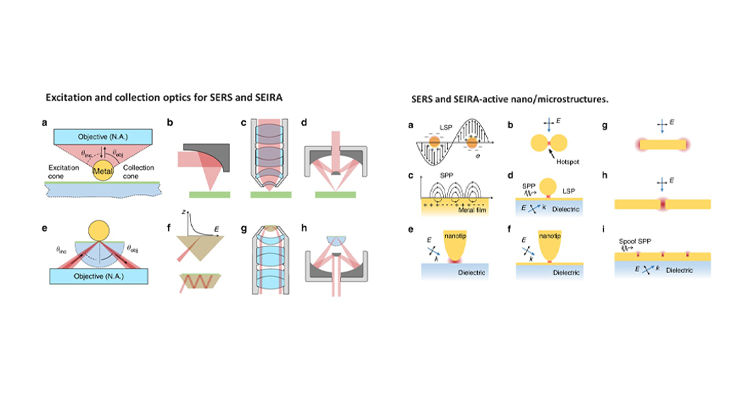 Dr Rajapandiyan Paneerselvam from the Department of Chemistry has published a paper titled “Advances of surface-enhanced Raman and IR spectroscopies: from nano/microstructures to macro-optical design” in the journal Light: Science & Applications, Volume 10, Article number: 161 (2021) having an Impact factor of 17.7.
Dr Rajapandiyan Paneerselvam from the Department of Chemistry has published a paper titled “Advances of surface-enhanced Raman and IR spectroscopies: from nano/microstructures to macro-optical design” in the journal Light: Science & Applications, Volume 10, Article number: 161 (2021) having an Impact factor of 17.7.Raman and infrared (IR) spectroscopy are powerful analytical techniques, which are widely used for a variety of applications including food analysis, environmental analysis, chemical, and biomolecule analysis. This review article presents some latest advancements in vibrational spectroscopic techniques, and further developments in this field are given with emphasis on emerging techniques and methodologies.
This article has been published with Prof Zhong-Qun Tian’s group, State Key Laboratory of Physical Chemistry of Solid Surfaces, Collaborative Innovation Center of Chemistry for Energy Materials, College of Chemistry and Chemical Engineering, Xiamen University, Xiamen, 361005, China.
Furthermore, Dr Rajapandiyan’s research group will focus on the development of plasmonic nanostructures for surface-enhanced Raman spectroscopy and its applications in food science, spectroelectrochemistry, and microfluidics in the future.
Read the full paper here: https://doi.org/10.1038/s41377-021-00599-2
Continue reading → - SRM University- AP celebrates Azadi Ka Amrut Mahotsav August 15, 2021
 In the midst of the coronavirus pandemic, India celebrates its 75th Independence Day across the country. SRM University-AP joined the virtual celebrations through the Zoom platform at 9.00 am on August 15, 2021.
In the midst of the coronavirus pandemic, India celebrates its 75th Independence Day across the country. SRM University-AP joined the virtual celebrations through the Zoom platform at 9.00 am on August 15, 2021.After the Flag hoisting and National Anthem which elicited patriotic fervour, the message for Independence Day was delivered by Vice-Chancellor Prof Vajja Sambasiva Rao. “The selfless sacrifice of freedom fighters has gifted us with a vibrant and strong democracy than other democratic nations. We must also take the path of selfless service and do whatever we can for the progress of our country,” Prof V S Rao said. “It is indeed our pride to say that our students are achieving greater heights through 100% placements, highly advanced research and starting their own companies through innovations”, he added. Prof D Narayana Rao, Pro-Vice-Chancellor; Ms Revathi Balakrishnan, Student Affairs Assistant Director; and Wg Cmdr Venkataachalam Sekkappan, Director-CLM; were present on the occasion. The event moved on to cultural performances by the students of the university.
India’s freedom warriors fought a long and arduous battle for the country’s independence from the British Empire. Their countless contributions and sacrifices are to be remembered forever. Commemorating the glorious lives of freedom fighters on “Azadi Ka Amrut Mahotsav”, SRM University celebrated this year’s Independence Day on the theme “Nation First, Always First.”
Continue reading → - Vivek Vardhan from ECE files design copyright August 7, 2021
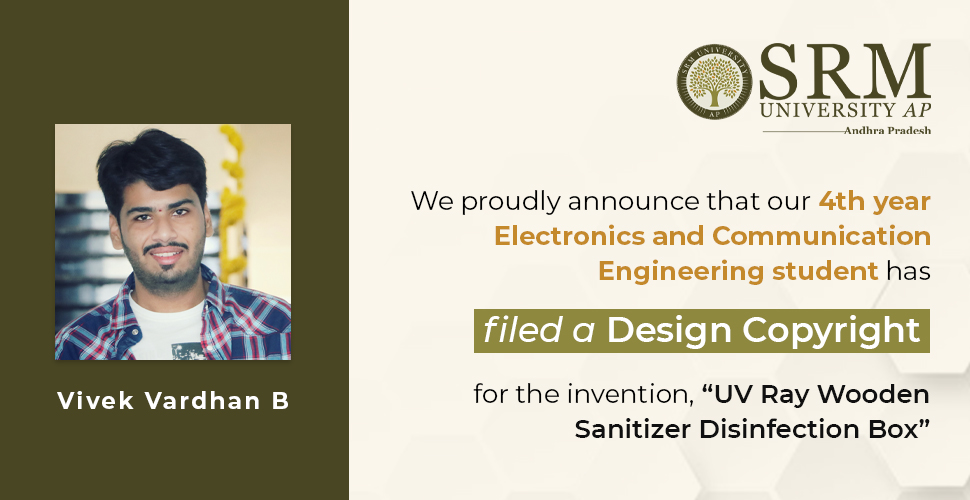 Bitragunta Vivek Vardhan, a final year student from the Department of Electronics and Communication Engineering, has filed a design copyright for developing a “UV Ray Wooden Sanitizer Disinfection Box”. This is a safe chemical-free product designed to disinfect the surfaces of items. In this period of the Covid-19 pandemic, it has been difficult to sanitize mobile phones, tabs, laptops, car/bike keys, wallets, currency/coins, credit/debit cards, newspapers, pens, goggles, spectacles, accessories, milk packets, bakery items, water-absorbing products, delivery packages, toys, clothes etc with liquid sanitisers or else with water.
Bitragunta Vivek Vardhan, a final year student from the Department of Electronics and Communication Engineering, has filed a design copyright for developing a “UV Ray Wooden Sanitizer Disinfection Box”. This is a safe chemical-free product designed to disinfect the surfaces of items. In this period of the Covid-19 pandemic, it has been difficult to sanitize mobile phones, tabs, laptops, car/bike keys, wallets, currency/coins, credit/debit cards, newspapers, pens, goggles, spectacles, accessories, milk packets, bakery items, water-absorbing products, delivery packages, toys, clothes etc with liquid sanitisers or else with water.Researchers say that the coronavirus stays on surfaces of plastic (3-7 days), stainless steel (3-7 days), copper (up to 4 hours), paper (up to 4 days), glass (4 days), cardboard (24 hours), and wood (up to 2 days). UVC has a wavelength of 10 nm to 400 nm and is used for the disinfection method that has short-wavelength light to kill or inactivate microorganisms by destroying nucleic acids and disrupting their DNA, leaving them unable to perform vital cellular functions. The UVC light used in the product will not penetrate into solid surfaces and it is safe to use on touchscreen mobiles, laptops, tabs, etc. It is also proven that the disinfection box can destroy the bacteria and viruses on the surface of food items without causing any harm to the edibility.
“In future, I have plans to take this project to the next level by designing large dimensions of the box and making it work automatically with remote control through our mobile phone. I am extremely happy about filing the copyright and I express my heartfelt gratitude to Prof Siva Sankar Sir and Pro VC Prof D Narayana Rao Sir for giving me the opportunity and supporting me to expand my idea up to the level of implementation. And I thank Prof Vinod Kumar Sir for taking care of the filing process. Finally, I thank SRM University-AP for encouraging and nurturing young talents in all ways possible, “ Vivek stated.
Continue reading →


